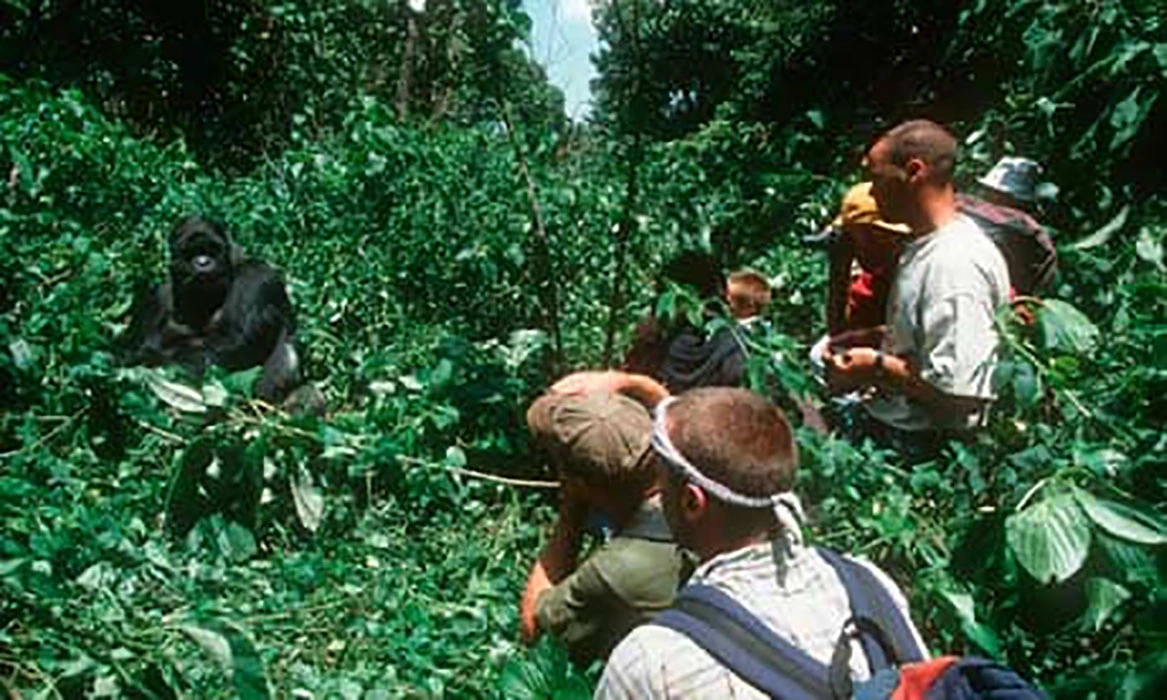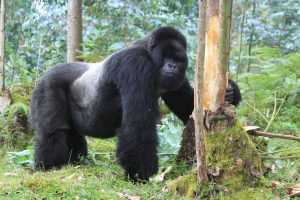How close can I get to the gorillas?
One of the most profound animal encounters on the planet is gorilla trekking. Travelers are left stunned, humbled, and forever altered when they encounter a mountain gorilla in its native environment. However, how near can you get to these magnificent primates on a walk? How close can I get to the gorillas? What are this kind of closeness’s guidelines, dangers, and benefits?
We’ll go over all you need to know about gorilla trekking’s safety precautions, distance restrictions, and conservation ethics in this extensive guide.
Gorilla trekking: What is it?
To view habituated gorilla families in the wild, gorilla trekking involves a guided journey across mountainous and densely forested areas. These hikes take place in national parks that are protected, like:
- Rwanda’s Volcanoes National Park
- Uganda’s Mgahinga Gorilla National Park and Bwindi Impenetrable Forest
- In the Democratic Republic of the Congo, Virunga National Park
Is It Possible to Get Up Close to Gorillas?
The official distance is seven meters or roughly twenty-three feet.
The International Gorilla Conservation Programme (IGCP) has established conservation rules that require hikers to keep a minimum of 7 meters (about 23 feet) away from the gorillas. For several reasons, this regulation is severely enforced:
Health Protection
Because humans and gorillas share 98.4% of their DNA, gorillas are particularly vulnerable to human illnesses.
Respect for Behavior
The animals may become stressed or change their natural behavior if they are too close.
Safety
Gorillas are still wild creatures despite their habituated lifestyle, and they may act aggressively if they feel threatened.
On the ground, gorillas occasionally disobey the rules.
Gorillas don’t always follow the rules, even though trackers and guides will try their best to keep tourists at a safe distance. A silverback might pass you up close, or curious juveniles might approach you. In these situations:
- Keep your cool and stay motionless.
- Steer clear of direct eye contact.
- Even if the gorilla touches you, avoid touching it.
The Significance of the 7-Meter Rule
-
Transmission of Disease
Humans can infect gorillas with COVID-19, the flu, and even colds. One of the main reasons why wild gorilla populations die is respiratory diseases. Because of this, hikers are frequently obliged to wear masks throughout the encounter
- If they’re sick, don’t go trekking.
- Wash your hands before the hike.
-
Ethics of Conservation
By keeping a safe distance, gorilla trekking can continue to be a sustainable activity. Long-term conservation of gorillas depends on minimizing human interference with their natural habitat and behavior.
-
Individual Security
A mature silverback is extremely robust and can weigh up to 200 kg (440 lbs). Respecting their space lowers the chance of inciting a protective reaction, even though attacks are incredibly uncommon.
How Are Gorillas Habituated?
Through frequent, non-threatening visits from researchers and park rangers, gorillas gradually become acclimated to human presence through a process known as “habituation.” This procedure, which may take two to three years, entails:
- Keeping a distance from the group
- Lowering the distance gradually over time
- Tracking behavior and stress levels
Tourists only visit habituated groups. This reduces the possibility of confrontation and guarantees that the gorillas are at ease with human observers.
Expectations for a Gorilla Trek
Before the Trek
Briefing
Depending on your degree of fitness, you will be placed in a gorilla group after receiving a safety briefing.
Group Size
To minimize impact, treks are restricted to eight participants each group. The majority of treks start early in the morning.
While Trekking
Depending on the gorilla group’s location, treks might last anywhere from thirty minutes to six hours.
- Trails will likely be steep, muddy, and heavily forested.
- You will be escorted by armed rangers and trained guides for your protection.
Once the gorillas have been located, you will have exactly one hour to watch them.
Photography is allowed; however, flash is not - Remain silent, proceed cautiously, and always do as your advisor directs.
Advice for a Respectful and Safe Interaction
- Keep a 7-meter distance at all times and wear a mask during the interaction.
- Steer clear of loud noises and abrupt movements.
- Avoid eating or drinking close to the gorillas.
- Always follow your guide’s instructions.
Concluding Remarks: A Sacred Distance
Trekking with gorillas is a privilege, not a right. In addition to being a regulation, the 7-meter rule is a sign of respect for one of our closest animal cousins. By keeping our distance, we safeguard these amazing species’ future as well as ourselves.
Thus, keep in mind that the distance between you is precious when you eventually meet a silverback in the foggy jungle. It’s the area where people and the wild coexist, where conservation flourishes, and where trust is established.




